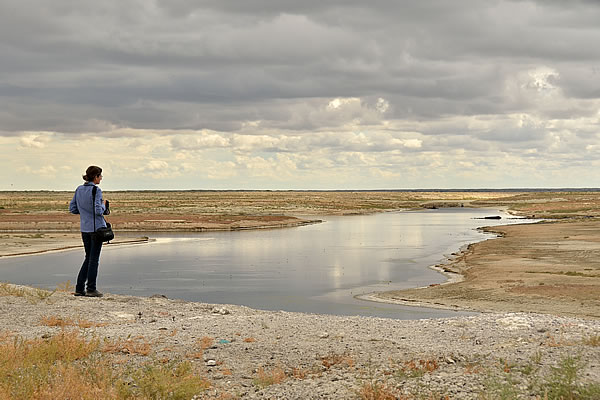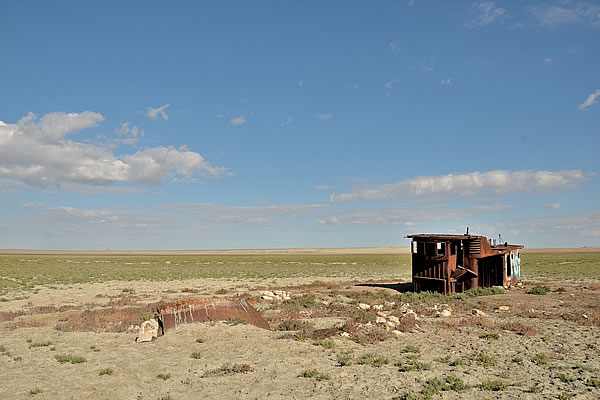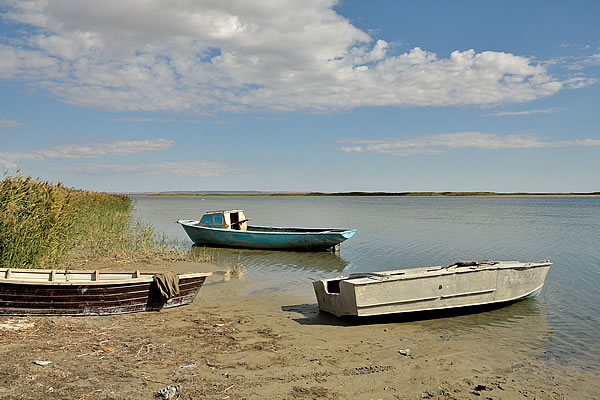

| Back to Aralsk and its sea | |
Uralsk (Kazakhstan), September 10th 2015
|
|
|
|
|
After almost twenty years we return to Aralsk, the town on the Kazakh steppe that is most associated with the Aral Sea; once the fourth largest lake in the world. It is generally assumed that the disappearance of this lake is the biggest environmental tragedy in the world that is directly linked to the activity of humans. Large-scale irrigation projects in this dry and less fertile part of the world led to the drying up of the two major rivers (Amu-Darya and Syr-Darya) that fed the Aral Sea with water. This was the sacrifice, consciously made by the Soviet Union, to produce large quantities of cotton, the most important agricultural product at the time of Central Asia. In 1996, when we for the first time visited Aralsk, a fishing town that was once on the shores of the Aral Sea, the disaster was immediately visible (see our article about Aralsk time). The water was gone from the port, the ships were rusting in the desert sand, and the giant cranes that once unloaded the fish from the ships, were sadly looking out over the steppe. The shore of the lake, at that time, was more than 40 kilometres away from town. Aralsk was changed from an energetic fishing community into a poor and dusty steppe town. And that was not all. Due to the drying up of this huge lake, a large concentration of salt and toxic substances (pesticides used to increase the growth of the cotton) were left in the steppe sand. The strong winds blew up these fine particles in the air, with all kinds of health problems as a result. |
|
 |
|
Ivonne looks at what was once the harbour of Aralsk |
|
Now, twenty years later, not much changed in town. It is still dusty and everything shows that Aralsk is not prosperous. The harbour is still empty, the ships are cleaned up by scrap dealers, but the cranes are still looking out sadly over the steppe; as if there's hope that they will be useful again soon. And that hope is perhaps justified. In 2005, the construction of the Kok-Aral Dam was finished and since that time the size of the Aral Sea is growing again. But this sounds better than it actually is. Through this dam, only a small part of the Aral Sea is saved. The dam prevents that the small quantities of water that reach the northern part of the lake through the Amu-Darya River, is not disappearing to the southern part of the lake. There is no hope anymore for the southern part of the lake, which was once mainly fed by the Syr-Darya River. Turkmenistan and Uzbekistan still use the water of the Syr-Darya River to the last drop, for its agriculture. So, the dam saves the northern part of the Aral Sea, but is the last pin in the coffin of the southern part of the lake. The dam should ensure that northern part of the Aral Sea will survive and one expects that the lake will even reach the town of Aralsk again in a few years from now. At present, the shore of the lake is still 18 kilometres away from Aralsk. But fishermen are fishing on the lake again, albeit with small boats, and 15 fish species have been returned to the lake through the Amu-Darya River. We wanted to see the reviving lake with our own eyes, so we decided to hire a jeep with driver. From Aralsk we drove over the dry and dusty steppe and realised that it was once the bottom of the Aral Sea. Some low and arid scrub is the only vegetation present. However, it seems to be enough for the camels, wandering in small groups over the steppe. It's hard to realize that we are heading to the shore of the lake that was once the fourth largest lake in the world. We stop at a number of shipwrecks, which are slowly ‘eaten’ by mother earth by the interplay of the arid, salty wind and the blowing sand steppe. The shade provided by the remaining parts of the rusty ship wrecks, are gratefully used by the camels to take a rest. It’s like we are part of a Mad Max movie. |
|
 |
|
Empty harbour and one of the remaining harbour cranes |
|
A little further, it looks like if we are seeing a Fata Morgana. The sand seems to reflect, but we still cannot believe that there is water in this climatically hostile area. But as we get closer, it is definitely true; a huge lake appears in front of us out of the steppe. And we are not the only ones that found the lake. Groups of Dalmatian Pelicans fly over our heads and to the lake to fill their stomachs with fresh fish. Small fishing boats are floating on the water from which men are throwing nets in the water. The reviving lake brings new hope to the people who suffered so much last decades. The Aral Sea is indeed working on a come-back, but everybody is convinced that it will never return to its full glory. Only the future will tell. But the first step is definitely a success. |
|
 |
|
A wreck of a fishing boat |
|
 |
|
Mother earth eats the ship wrecks slowly |
|
 |
|
Mad max atmosphere |
|
 |
|
Camels enjoy the shade that the ship wrecks provide |
|
 |
|
The northern part of the Aral Sea is on its way back © copyright - Babakoto.eu / 2015 |
|